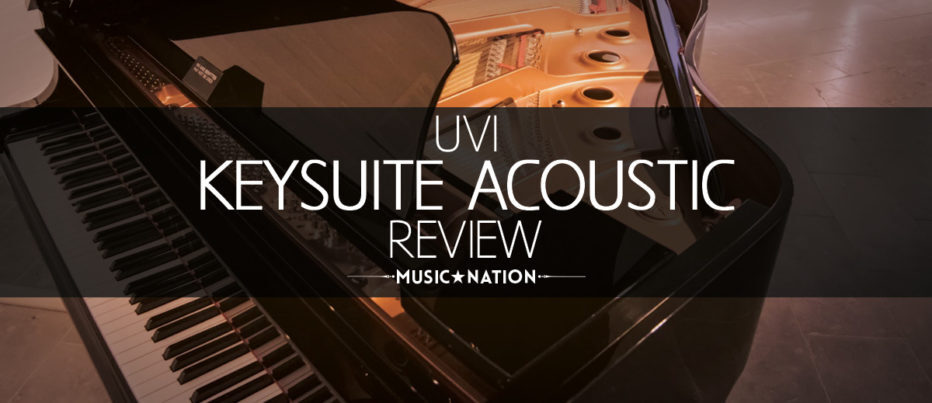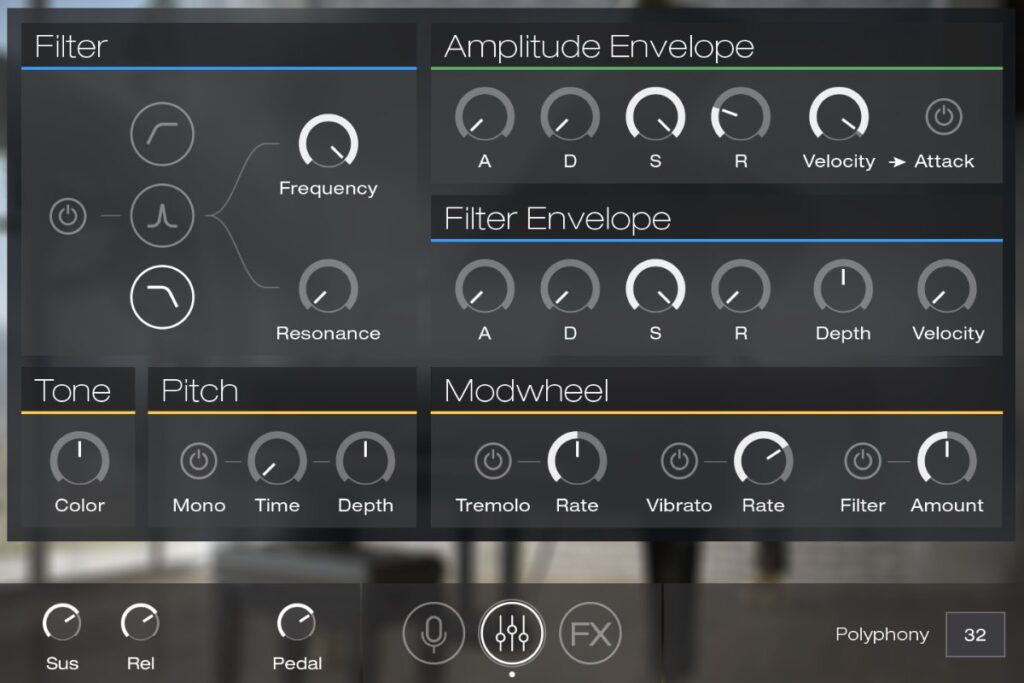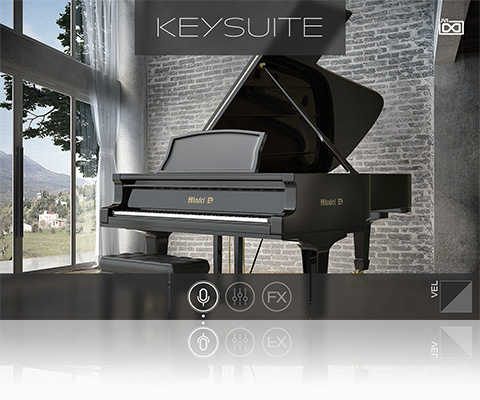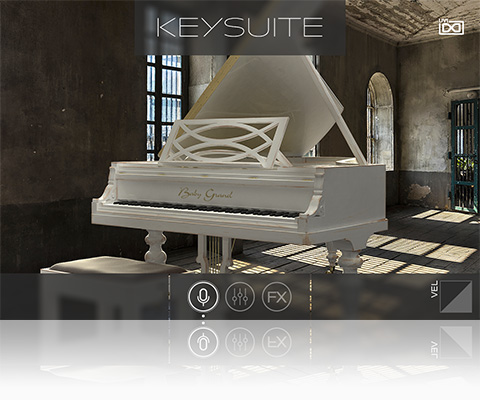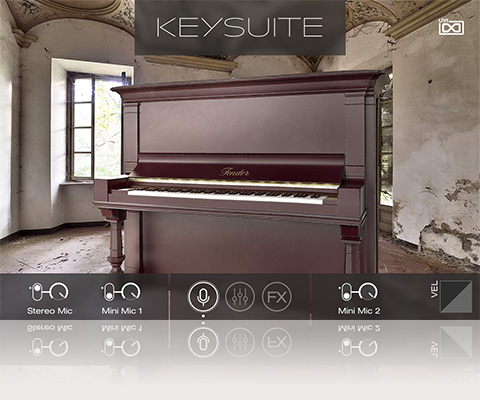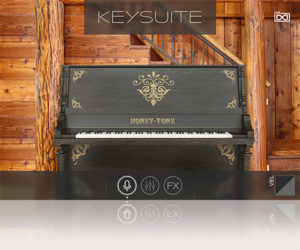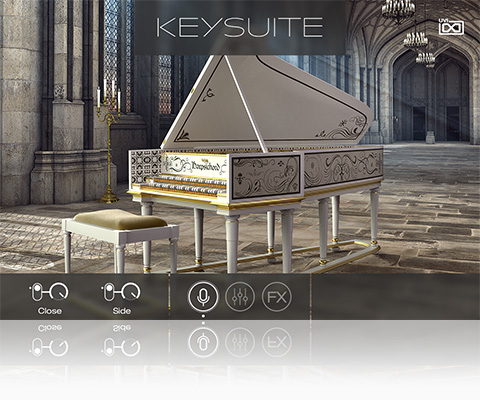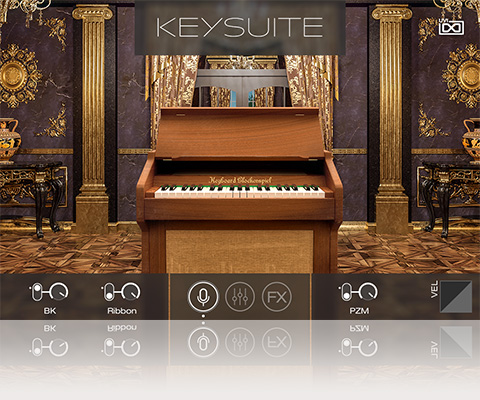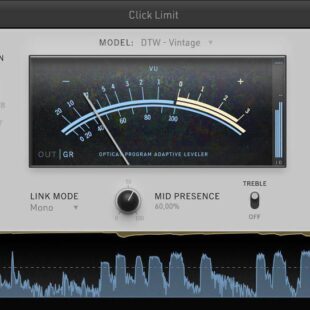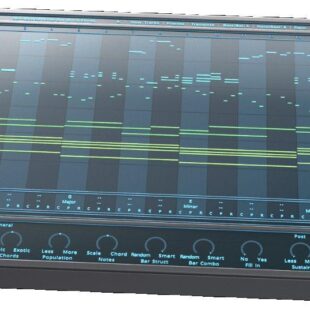UVI KEY SUITE ACOUSTIC – SWEET KEYS
Welcome to our in-depth look at UVI’s latest comprehensive offering. There are certainly plenty of piano sample libraries to choose from these days, but UVI promises a full-featured collection of deeply-sampled and immaculately recorded pianos, plucked keyboards and percussive metallophones all in one handy collection. All of which sounds very tempting indeed.
UVI’s quite prolific catalogue of Workstation/Falcon expansion libraries is rounding out well with recent additions, making the entire platform a strong consideration for those frustrated or bored with the conventional Kontakt environment.
The crowning flagship of any good virtual instrument collection is the piano, the one instrument that you get wrong at your peril. To play a few bars on a bad piano could cause the entire platform to be snubbed by some, so this new expansion could be seen as a make-or-break moment for UVI.
Exciting stuff, so let’s get Key Suite Acoustic installed and see how it fares.
Overview
UVI Key Suite Acoustic is a 13GB sample library for the UVI Workstation (free) or Falcon ($349USD) platforms, featuring 20 keyboard-style instruments, full filter and envelope controls and a new effects rack. Categories include eleven grand and upright pianos, four plucked strings and five bell-like struck metallophone-style instruments.
The library downloads as a single ‘UFS’ file for easy placement on your system drive with other UVI expansions. As with all UVI products, an iLok account with online activation is required.
UVI has the entire checkout and download system dialled in, relieving your credit card and downloading your product before you’ve had enough time to make a coffee.
Recommended specs are 4GB RAM on a 7200 RPM drive. However, we found our 16GB system performed only adequately, with some CPU spiking when pushed. So I think the realistic minimum is 16GB RAM, with an SSD highly recommended.
I was able to max out my DSP on a couple of the grand piano presets by loading up on reverb then pushing the polyphony too far by holding the sustain pedal down like a gorilla. Nothing to crash the system or anything, just a few crackles of complaint from our admittedly ageing i5 920 CPU.
First Impressions
First impressions of a new instrument are so important. Synths and drum machine instruments have the advantage of an unsophisticated benchmark. Pianos, on the other hand, need to demonstrate realism, tactile feel and emotional feedback from the first few notes that you hear.
If a piano doesn’t feel ‘right’ at the fingers, you will never truly become emotionally connected to it.
Visually, Key Suite Acoustic’s minimalistic front end is classy and restrained – qualities I like in a high-end product. Patches present with the main window showing the instrument in question, mostly with little else to distract your attention. The high-resolution graphics look fantastic and for the most part, visually describe quite well the basic tone of the instrument chosen.
The secondary tabs lead to further controls which I will cover later in this review, all of which are well laid out and nicely tucked out of the way until you need to dig down deeper.
My first impressions on most patches were good. A little too much aggression on the velocity (sometimes) was easily fixed with a slight tweaking to the graphic on the main page. Each piano has a unique character, so it took me a few passes to figure out the ones that appealed to me most.
The most immediate thing I noticed with all the patches was the clever pedal, resonance and room ambience. All instruments sound very lifelike and dynamic, possibly a little too much in places requiring some softening of the settings depending on the arrangements you’re playing.
Testing the Waters
I tested Key Suite Acoustic on three different keyboards as I am very interested in the response from both synth-action and fully weighted controllers.
Firstly a Korg NanoKey 2, which is quite possibly the worst MIDI controller for any degree of feel or dynamics; next, my beloved Roland Jupiter80, with its spring-weighted synth action (non-waterfall); finally my fully-weighted 88-note Yamaha MOTIF for the full immersion.
As expected, the tactile feedback from the little Korg was, at best, terrible – but I didn’t feel software minded the limited velocity input so much. Sure,
playing on the tiny plastic keys makes everything sounds quite one-dimensional, but for pop, EDM or the like, a fair bit can be accomplished and curiously, the limited dynamics can actually lead to some quite interesting results.
The light synth action of the Jupiter80 strikes a midpoint between the three controllers, and I would assume most producers are using similar keyboard controllers in their setups. The extra velocity scaling from the hardware adds more to the tactile feel, but I have a habit of striking the keys too hard (due to them being very lightweight, and my tendency to be a little too passionate when playing the piano), making the synth feel too aggressive for some of the more delicate instruments in the library.
The MOTIF, with its gorgeous fully weighted 88-note keyboard, performed superbly with Key Suite Acoustic. The full 128-point velocity feels much more sensitive with the heavier keys. For harder rock and pop lines, I found bashing the keys never sounded unnatural as the synth-action tended to do, but for softer ballads, jazz and classical melodies the Yamaha really brings out the character in the library.
Which would I prefer? Probably the weighted action – but I would not say it is essential. The biggest difference is in the lighter moments when a softer touch is required the synth action and plastic Nanokey Korg need a slight velocity scaling adjustment to compensate.
But there is no doubt, for trained pianists and those requiring more detail and feel, the weighted controller is the only option.
The Effect Rack and presets
Interestingly, all instruments (except the Metallophone category) contain the same presets (Dry, hall, mellow dark, bright, phaser, radio FX, romantic and Rotary), making comparisons easy. But some more specifically tailored patches would be nice.
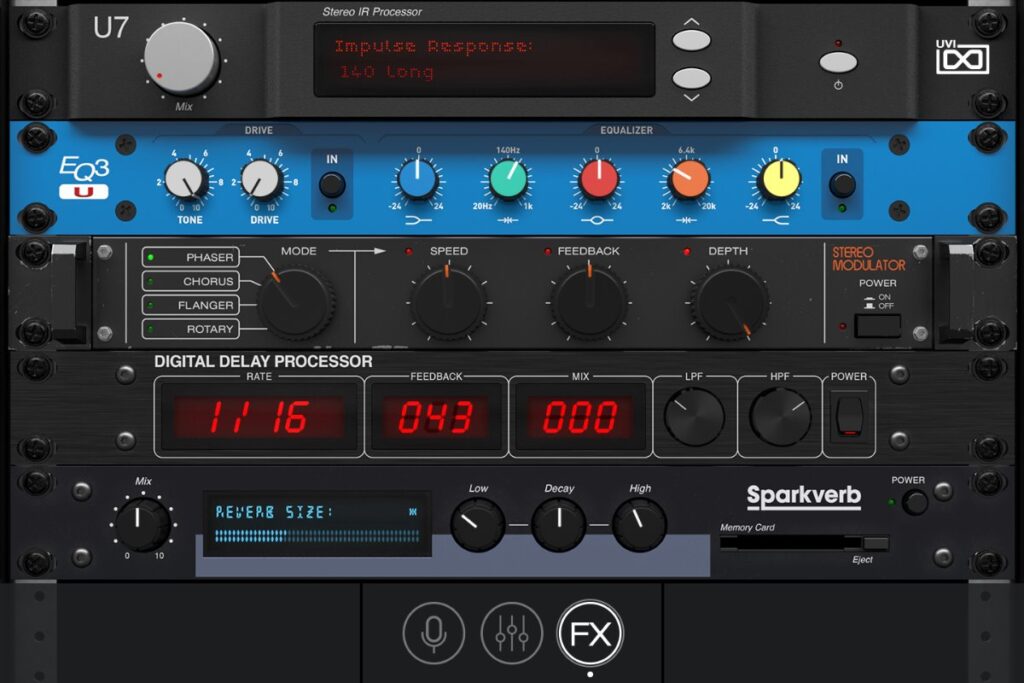
Each instrument patch contains the same three sections; mic settings (if any are available), mixer (for filtering and envelopes) and the FX rack.
The filter and envelope mixer section contains plenty of controls to dial in the best tone and feel. A cut-off and resonance with three filter types and both amp and filter ASDRs are available. Modwheel options for tremolo, vibrator or filter amount provide good flexibility.
There is a pitch control with a time offset, mono and poly switch, and controls for the pedal noises plus an interesting Tone/Color control that can totally transform the sound of the instrument. This singular control is well-worth playing with for each of the presets as the rather broad results vary for each instrument.
What looks to be a rather simplistic library on the surface is actually quite well-equipped with effects. The FX rack tab is a new departure for UVI, containing 5 specifically tailored effect rack units for the library. In a very similar fashion to EastWest’s Play’s effect section, Key Suite Acoustic contains some quite distinctive themed rack units you will no doubt recognise immediately.
The Bricasti M7 and Maag EQ4 had my hopes up these were IR sampled effects from the real McCoy, but alas only nifty-looking macro controls for Falcon’s back-end effect chain.
Having said that, they all sound excellent and are quite well suited to piano processing, with plenty of scope for getting some drive and wacky modulation effects going.
Though these rack units are simply clever macro controllers for the standard Falcon effect processors, there is something cool about having them presented in this way. They all sound good and I think well matched to the library’s instruments.
I found layering multiple instruments quite rewarding, particularly a grand piano and one of the plucked or metallophone patches. Likewise, using the bell tones of the J-Celeste and other similar keyboards works beautifully with other UVI synths in the range.
One by One
Time for a quick-fire opinion of each of the included instruments. These were all played with my weighted 88-note MOTIF, and I must stress these are my opinions only – I am not a trained concert pianist, more an enthusiastic amateur with around 25 years under my belt, so take my thoughts as you wish.
The Grands:
Baby Grand: A little disappointing in both dynamics and tone for me. A rather thin-sounding instrument that is too bell-like for my taste, specifically in the high register. Having said that, this is a well-captured recording that responds very well to processing and effects, I can see plenty of scope for sound design and other creative uses.
Hybrid Custom: Very woody with plenty of moody resonance. This tone won’t suit all applications but to my ears, it is one of the more realistic sounds right out of the box. The ever-so-slight mistuning and boxiness give this piano a gorgeous tone, especially with extra reverb applied. The top-end register is amazing. Perhaps a little too over-hyped with the mic placements, I found a slight reduction in the tone that sounded better.
The FGrand: I absolutely adore this instrument. It is probably my favourite in the collection. This is a very upfront-sounding piano, quite bright with strong mids, so ideal for pop and rock arrangements. Out of the box, it has the best balance of dynamics and ambience sound. This piano sings when played with an 88-note, but I found the synth action causes it to bite too hard and sound rather harsh in the midrange unless you pull back the velocity curve slightly.
Japanese C7: Very heavy and dark sounding. I love it. You can really feel the weight of the instrument and the top register has a lovely resonance. As a solo instrument, this is probably my go-to, but some degree of EQ control is required to rein in the power when coupled with an orchestra or band. I have played a few full-scale concert pianos, and they have an immense presence and power that it probably impossible to capture in software, but this imitates many of those overtones and soundboard resonances I associate with the real C7
Model D: The iconic ‘D’ is a must-have in any collection, and sadly one I have not played in real life. This instrument has been recorded superbly and is easily on par with others I have in my software collection. Darker and moody than most, but very cutting when hit hard. The most dynamic range of the lot with possibly the best feel. The sound is very suited toward traditional orchestral and solo applications, probably a little too characteristic for pop and rock.
Uprights:
German Upright: Very nice tone with a definite old-world charm. There isn’t much dynamic range but it doesn’t affect the playability which I found quite enjoyable. Less boxy than your typical upright, this works well with most musical applications.
Grand Upright: Fabulous resonance on this instrument. It is by far my favourite of the uprights. The dynamics are also quite good, with a lot of velocity resolution between soft and heavy play styles. Having said that, this will bark back at you if hit too aggressively, the top 10-15% of the velocity scale feels a little too over-tuned maybe. This piano responds very well to the reverb effects and even a slight bit of delay or modulation.
Grand Upright includes three microphones to dial in the perfect mix. A punchy mono, back and front ribbon. A great touch adds flexibility to the overall tone.
Honky-Tonk Upright: This is loads of fun, I only wish I had more bluesy skills better to use the sound of this. The tone is wonderful. The piano almost feels like it is about to fall to bits. The resonance echoes for an age and the characteristic tuning sounds realistic, not forced or digitally manipulated. This is not an instrument I would use daily, but for folks looking for this kind of thing, I think this is one of the best on the market.
Tack Upright: This crazy piano sounds very thin and metallic, due to the tacks applied to the hammers for more volume.
Not quite my thing, but great to see it offered as part of the collection, possibly one day a need for this instrument will arise but for now I can see it gathering a lot of dust at the back of the collection.
Tender Upright: A lovely sounding instrument, the tone immediately transported me back to the turn of the century. It is perfect for a period film. Not as much dynamic range as I would have liked, but the tone and resonance lean towards a more flat and neutral-sounding instrument. Love the old charm of this one, definitely a must-play.
The Compact: Surprisingly versatile sounding little piano. I prefer the velocity pulled back a lot, as out of the box it sounds very aggressive and metallic. The soundboard resonance is most unusual, with a very tight attack and strange key release, this takes some time to get used to. A very pretty sounding instrument with lighter sound when set up correctly, that also responds very well to intensive reverb and other effect processing.
Plucked Strings:
Blanchet Cembalo: I absolutely love this instrument. Wonderfully Victorian sounding and has plenty of dynamic range for a surprisingly playable instrument. Out of the box, it comes with rather intense velocity settings, reflecting the original instrument (I assume).
Clavichord: Not as pleasing to play as the Cembalo, this similar-sounding instrument certainly offers plenty of old-world charm. Quite a boxy sound but not offensively. I was hoping for a little more character.
Harpsichord: This instrument is a beast! By far the most powerful Harpsichord I have played, out of the box this is very aggressive and upfront sounding. So intense and gothic – I really enjoy this keyboard.
This is the only instrument in the range that features a unique mixing tab, allowing the user to enable various string layers of the instrument. A mix of either the 4′ string, 8′, the 8′ mutes and a second set of 8′ strings for a monstrous sound.
On its own, this instrument is almost worth the cost of the library. A real highlight.
Spinet: I am not familiar at all with this instrument and am not overly impressed with the tone. It is a medieval instrument, and I am sure folks looking for this type of thing will put it to better use than I did.
Metallophone:
Celesta: Wonderful midrange with a lot of resonance, possibly a little too much for my taste. This instrument doesn’t have a massive dynamic or key range, but in the middle range, it sounds fantastic.
Dulcitone: Quite aggressive hammer noises, somewhat covering the light tone of the instrument. Not a fault of the recording, this instrument is no doubt very percussive naturally. I’m guessing this has quite specific applications. It is interesting, is a little too boutique for me.
J-Celeste: Fantastic sounding very bell-like instrument. The top-end range breaks up nicely giving this delicate-sounding instrument a wonderful brittleness. I particularly like to layer this instrument with others in the library, and even 3rd party synths for an ethereal bell attack, with an ever so slight mistune that sounds excellent coupled with a digitally lifeless synth.
Keyboard Glockenspiel: Another awesome-sounding instrument with a brighter tone to the J-Celeste. It is similar to a music box and I expect you will find many opportunities to use this patch in your arrangements. Again, this instrument loves to be layered and sounds incredible with plenty of reverb and delay.
Papageno Bells: Similar in tone to the Glockenspiel but not as pretty. The bells sound quite plonky and don’t stand up well as a solo instrument, but I had some enjoyment using this to emphasise passages in an orchestral piece. As with others in this category, plenty of reverb and delay take this to a whole new level.
Conclusion
There is no doubt Key Suite Acoustic offers excellent value for money. In my view, it would be so with just half of the included instruments.
Expanding on the already excellent back catalogue of expansions for Falcon and Workstation platforms, UVI has hit a home run with this bundle.
Though the flagship instruments are the grand pianos, I personally found more interest in the plucked string selections, particularly the harpsichord which is outstanding. From a sound design point of view, I found these quite creative to layer with other pianos or synths for some quite interesting results. These also respond best to modulation processing like the Thorus and Flanger effects.
By default most of the presets are a little too aggressive with my synth-action keyboard, requiring slight tweaking to the velocity curve each time you load. On the whole, everything feels much better using a fully-weighted action controller.
The technology at work here is quite sublime. How the library is capable of delivering so much content at such high quality for a 13 GB data footprint is quite impressive.
UVI has provided an excellent collection of well-known standards and left-field oddities in a well-laid-out, simple-to-use workflow.
This important addition to the ‘Suites’ series makes Falcon/Workstation one of the most well-rounded and value-for-money platforms on the market.
UVI has nailed the performance, sound and tactile feel with Key Suite Acoustic, delivering an essential cornerstone expansion for the Falcon/Workstation platform, and in my opinion a must-have for anyone producing music on the PC.
Full details on this and other UVI expansions can be found on the website right here www.uvi.net

Like the review? Shout us a cup of coffee!

